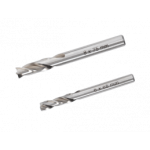hi, my tips:
for thin metal use specific bits. When thickness is more important, start drilling on one side and return piece to complete the drilling. For big diameters, drill through a piece of cotton. Of course respect correct speed according to diameter and material. No deburr 😉
for thin metal use specific bits. When thickness is more important, start drilling on one side and return piece to complete the drilling. For big diameters, drill through a piece of cotton. Of course respect correct speed according to diameter and material. No deburr 😉
Attachments
Last edited:
It avoid stripping material with large diameter. Same principle with particleboard when you stick tape before cutting through it with saw.
Cellotape also works good when one has lightly used a center punch to indicate the exact right spot of the hole. Light deburring so only a slightly recessed hole is possible with a dull large drill and some oil works good. No pressure and have the drill limited in depth to avoid differences.
Please not that perfectly "flat" holes only work out OK when anodizing aluminium. When using paint or powder coating having deburred holes works way better.
also: in my limited experience I find that "sharp" holes gather dust and dirt faster than dull/rounded holes. A second good idea is to have the device limited in dissipated power, design for highest efficiency/lowest losses and use the casing as a heatsink. That is better in quite some aspects not in the least for Swiss power bills. For instance adapt needed power of power amplifiers to real life requirements and choose devices accordingly. Any needed ventilation hole, fan and such requires time/work, creates risks and it is detrimental for ease of use as it requires maintenance, cleaning etc. Gathering from what I see at the average audio DIYer dusting off is not on their priority list 🙂 The result in post #1 is quite good but one may ask himself if making a large rectangular opening at the upper back side and a large rectangular opening at the front side of the chassis just behind the faceplate is more effective. No holes visible too! In some devices with thermal issues I did such and it works pretty well. Milled slots with rounded corners are nice looking too. Make sure air can enter the device adequately too, you want air flow.
Please not that perfectly "flat" holes only work out OK when anodizing aluminium. When using paint or powder coating having deburred holes works way better.
also: in my limited experience I find that "sharp" holes gather dust and dirt faster than dull/rounded holes. A second good idea is to have the device limited in dissipated power, design for highest efficiency/lowest losses and use the casing as a heatsink. That is better in quite some aspects not in the least for Swiss power bills. For instance adapt needed power of power amplifiers to real life requirements and choose devices accordingly. Any needed ventilation hole, fan and such requires time/work, creates risks and it is detrimental for ease of use as it requires maintenance, cleaning etc. Gathering from what I see at the average audio DIYer dusting off is not on their priority list 🙂 The result in post #1 is quite good but one may ask himself if making a large rectangular opening at the upper back side and a large rectangular opening at the front side of the chassis just behind the faceplate is more effective. No holes visible too! In some devices with thermal issues I did such and it works pretty well. Milled slots with rounded corners are nice looking too. Make sure air can enter the device adequately too, you want air flow.
Last edited:
This is very dangerous.For big diameters, drill through a piece of cotton.
This trick was used since a long time in industry before CNC. Don't steal your wife's dress, you just need a small piece of cotton folded in 4 🙂 . Usefull between 10 to 15mm. Above, a punch tool or drill bit (XLR...).
I usually use one of these
https://www.amazon.com/VASTOOLS-Deb...hvlocphy=&hvtargid=pla-4584345030105494&psc=1
https://www.amazon.com/VASTOOLS-Deb...hvlocphy=&hvtargid=pla-4584345030105494&psc=1
I‘ve got and tried it, they’re good for diameters >5 mm, and the smaller the hole, the mor difficult it becomes…
Jean-Paul's idea is good, the old valve radios had large cut outs in the bottom or front, and in the back or top for convective circulation.
A fine steel / fiberglass mesh will help reduce the bug problem, then a blower service will be sufficient.
A piece of cotton fabric, that might be better for de-burring, a heavier fabric, nearly like canvas, may be stronger.
Another trick is to stick some abrasive paper on a slightly under-size drill, and use that to finish holes.
Or get a mounted point in taper shape / its metal equivalent, dentists use those a lot, may be cheap in that section.
A fine steel / fiberglass mesh will help reduce the bug problem, then a blower service will be sufficient.
A piece of cotton fabric, that might be better for de-burring, a heavier fabric, nearly like canvas, may be stronger.
Another trick is to stick some abrasive paper on a slightly under-size drill, and use that to finish holes.
Or get a mounted point in taper shape / its metal equivalent, dentists use those a lot, may be cheap in that section.
- Home
- Design & Build
- Construction Tips
- How to deburr holes in Aluminium without creating a countersunk drilling?
